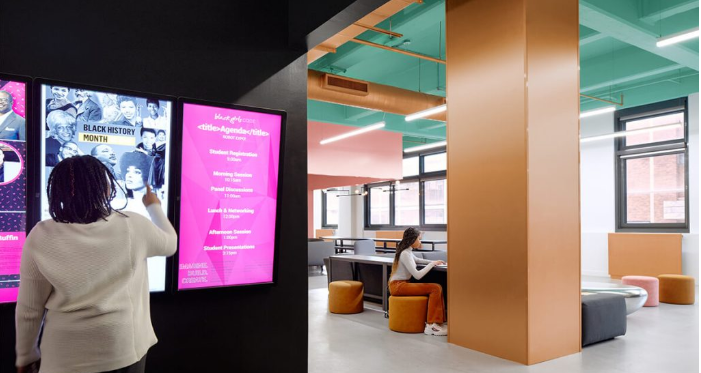How can schools reopen safely this fall amidst the ongoing COVID-19 pandemic?
This question is on everyone’s minds lately in the NY metro area— educators, students, and parents alike. Though it is largely understood that no single action will eliminate the risk of Coronavirus transmission entirely— intervening with multiple, coordinated procedures and protocols can work to reduce the risk significantly.
Currently, two top indicators for a safe & successful school reopening are:
— 01 —
The ability to socially distance within school grounds.
— 02 —
The implementation of new protocols.
With less than one month left before the start of the new school year, time is of the essence for schools to implement these necessary changes. Here’s some ideas on how private and charter schools in NYC can effectively do both:
Campus & Classroom Modifications
Returning to in-person learning means schools must be fit to provide appropriate social distancing measures, as well as personal protective equipment (PPE) for all students and staff. Schools must be prepared to modify the physical layout of their campuses, classrooms, and other facilities— according to the Reopening Guidance for Religious and Independent Schools released by the NYS Education Department on July 27, 2020.
As stated by the NYS Education Department’s Reopening Guidance for Religious and Independent Schools, all private and charter schools are required to adhere to local and state public health and education requirements. This means all schools set to reopen in the NYC area this fall are required to meet the guidelines of the NYS Education Department, NYS Department of Health, and Centers for Disease Control and Prevention.
Alongside outfitting classrooms, restrooms, dining areas, and other communal spaces with protective barriers (think: plexiglass shields, sneeze guards, partitions, and divider boards) many schools are looking to construct large-capacity, alternative spaces. One way to go about this is by creating outdoor learning spaces which greatly reduce the risk of transmission that tends to go hand-in-hand with traditional, indoor classrooms.
Another way to create more space for social distancing in schools is by adding square footage onto their existing facilities. This solution allows for more physical space between people, thereby maximizing the number of students per class.
Building Operating System Enhancements
In addition to the solutions mentioned above, all New York City schools should consider updating their building operating systems in the months that lie ahead. This would include updating their facilities’ ventilation, filtration, and plumbing systems.
Ventilation systems should be operating properly — ensuring the maximum circulation of outdoor air — and more windows can be created in classrooms where it is safe to do so. In addition, plumbing systems should be modernized to include hand-washing stations outside every classroom for use before, during and after class.
Smart Schools: Where Artificial Intelligence (AI) Meets BMS
To go a step further, schools now have the option to marry their building operating systems with artificial intelligence (AI) to mitigate the spread of transmission. “Smart schools” include building management systems (BMS) that monitor air quality, detect fevers among large masses of students/staff, and even analyze classrooms for maximum capacity (with social distancing measures in mind, of course). These capabilities can work to reduce the spread of COVID-19, as well as ease anxiety among the student and faculty populations returning to school.
As a bonus, there really is no time like the present to make your building systems sustainable and energy-efficient in a way that is cost-effective for all parties involved.
Listen to our conversation with Dr. Teghpal Sandhu of Live Building Systems on Episode 3 of Talisen Talk to learn more about smart buildings and the importance of building system analysis & data monitoring.
For additional mandatory health and safety requirements and considerations for reopening schools, please refer to the guidance released by NYS Department of Health (DOH) on July 13, 2020.
Known for completing even the most complex projects, with strict time constraints, both on time and on budget, Talisen’s mission is to build for resiliency by providing premier construction services in the New York metropolitan area. Health and safety considerations come first in every decision we make and action we take on your education construction project, as we remain dedicated to serving our NYC community and the educators and students in it.
Contact us today to learn how we can help with your education construction project.
How to Adapt Virtual Learning: Remote Learning Resources
For schools opting to conduct either full-time or part-time virtual learning, there are a host of remote learning resources available for use.
It’s true that Talisen strives to build effective construction solutions for our NYC community— but we don’t stop there. We pride ourselves on building a keen awareness of the latest technological innovations. As such, we’ve compiled a list of helpful remote-learning resources for educators, students & parents alike during these unprecedented times. Please see below:
Technology Resources & Tips, Charter School Remote Learning Models, Special Education & MLL/ELL Resources, and Resources for Families (The NYC Charter School Center)
Distance Learning Solutions (UNESCO)
The IT Investment Priorities Shaping Today’s School Districts (EdTech)
10 Educational Technology Solutions for COVID-19 Out-of-School Children (ICTworks)
